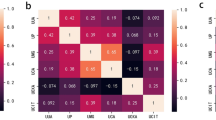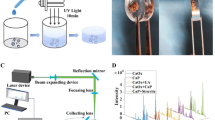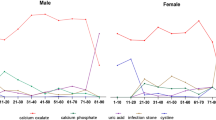Abstract
In our attempts to prevent or treat urinary calculi, we recommend that the patients should force fluids.
This work was undertaken to determine whether it is possible by dilution to maintain the urine of paraplegic patients in a condition of undersaturation with stone-forming salts and, if so, what level of urinary output per 24 hours is necessary.
The subjects studied were 17 spinal cord patients and two control subjects. They all attempted to vary their fluid intake to give a wide range of 24-hour urine volumes. After analysis, the relative saturation (RS) of the urine with respect to the relevant salts was obtained from the Marshall-Robertson nomograms modified to take account of changes in ionic strength. The 24-hour volumes required to reduce RS to zero were found to be 1.3 to 10.1 litres for brushite, 0.3 to 8.3 for octocalcium phosphate and 0 to 1.9 litres for magnesium ammonium phosphate.
A nomogram was constructed to permit calculation of the 24-hour volume required to maintain urinary under-saturation after measurement of calcium, of phosphate and of pH. The use of this nomogram will facilitate assessment of whether dilution therapy is likely to be helpful in the treatment of stone disease in any particular case and whether it will do so in the face of the high alkalinity usually encountered in infected urine. We have compared the effects of hard water and soft water and attempted also to calculate what level of NaCl intake would be needed to achieve the same effect.
Similar content being viewed by others
Log in or create a free account to read this content
Gain free access to this article, as well as selected content from this journal and more on nature.com
or
References
Bates, R G, Staples, B R & Robinson, R A (1970). Ionic hydration and single ion activities in unassociated chlorides at high ionic strengths. Analyt. Chem., 42, 867–871.
Burr, R G (1978). Urinary calculi composition in patients with spinal cord lesions. Arch. Phys. Med. Rehabil., 59, 84–87.
Clark, P B & Nordin, B E C (1969). The problem of the calcium stone. Proc. Renal Stone Res. Symposium, Leeds 1968, A. Hodgkinson & B. E. C. Nordin (eds.), pp. 1–5. Churchill, London.
Conway, B E (1952). Electrochemical Data, p. 102. Elsevier, New York.
Finlayson, B (1974). Renal lithiasis in review. Urol. Clin. N. Amer., 1, 181–212.
Kohn, R & Furda, I (1967). Calcium ion activity in solutions of calcium pectinate. Collect. Czech. Chem. Commun., 32, 1925–1937.
Marshall, R W & Robertson, W G (1976). Nomograms for the estimation of the saturation of urine with calcium oxalate, calcium phosphate, magnesium ammonium phosphate, uric acid, sodium acid urate, ammonium acid urate and cystine. Clin. Chim. Acta, 72, 253–260.
Modlin, M (1967). The aetiology of renal stone: a new concept arising from studies on a stone-free population. Ann. Roy. Coll. Surg. Eng., 40, 155–178.
Thomas, W C, Jr. (1969). Inhibitors of mineralisation and renal stones. Proc. Renal Stone Res. Symposium, Leeds 1968, A. Hodginson & B. E. C. Nordin (eds.), pp. 141–151. Churchill, London.
Thomas, W C, Jr. (1974). Medical aspects of renal calculous disease. Urol. Clin. N. Amer., 1, 261–278.
Wade, A (1977). Martindale: The Extra Pharmacopoeia, 27th ed., p. 1447. The Pharmaceutical Press, London.
Author information
Authors and Affiliations
Rights and permissions
About this article
Cite this article
Nuseibeh, I., Burr, R. The effects of varying water intake and of other measures on the relative saturation of stone-forming salts in the urine of spinal cord patients. Spinal Cord 17, 363–370 (1979). https://doi.org/10.1038/sc.1979.68
Issue date:
DOI: https://doi.org/10.1038/sc.1979.68



